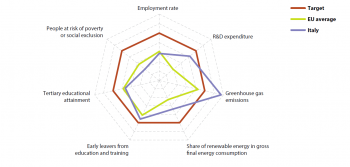Archive:Europe 2020 indicators - country profiles
This article is part of a set of statistical articles based on the Eurostat publication Smarter, greener, more inclusive - Indicators to support the Europe 2020 strategy, providing recent statistics on the Europe 2020 strategy of the European Union (EU); it introduces the country articles outlining the situation at national level in relation to the Europe 2020 headline indicators and specific national targets (see list).
Country profiles
This section provides a detailed picture of the situation at national level in relation to the Europe 2020 headline indicators and national targets. The focus lies on summarising for each Member State the state of play in relation to its national targets.
As already mentioned in the introduction, Member States have defined their national targets in their National Reform Programmes (NRPs), reflecting the current situation of each country. The NRPs outline the actions and measures planned in each country to progress towards the national targets. They are supported with country-specific recommendations issued by the European Commission after the assessment of the national programmes. The complete NRPs and country-specific recommendations can be downloaded from the European Commission’s Europe 2020 website.

Source: Eurostat, see dedicated web section: Europe 2020 indicators dedicated website
The presentation of each country is supported by an illustration in the form of a radar chart. The chart in figure 1 shows the distance of a country to its national targets relative to the range of distances observed across all Member States and relative to the EU average. The closer a country is to the centre of the ‘spider web’ for an indicator, the greater its distance to the respective national target. Thus the country has to make a greater effort than other countries to meet its national target. On the other hand, the closer a country is to the outer red line of the spider web, the closer it is to the respective national target. Figures outside the outer line mean the country has met this target, thus showing the degree of ‘overachievement’.
The green line in the radar chart shows the average EU distance to the overall EU-level targets. The comparison of a country’s performance with the green line reveals whether a country is performing better or worse than the EU as a whole. National targets that are not harmonised with the overall EU targets are not presented in the diagram. For example, this is the case for energy efficiency, where in line with the Energy Efficiency Directive Member States can set indicative national targets based on different indicators (primary or final energy consumption, or primary or final energy savings, or energy intensity).
Progress towards the national greenhouse gas (GHG) emissions targets is analysed based on emissions in sectors not covered by the EU Emissions Trading Scheme (EU ETS) and in relation with the base year defined in the Effort Sharing Decision (ESD). [1] For further details on the EU ETS and the ESD see the section Climate change and energy. Concerning the analysis of progress towards the R&D target, at the time of drafting this publication all data referred to ESA 95 based GDP. The current Eurostat database provides R&D intensity data where the denominator (GDP) is based on the ESA 2010 methodology. For the EU-28 as a whole, the use of ESA 2010 GDP lead to a downwards revision of R&D intensity by around 0.07 percentage points.
The national targets (as defined in the NRPs) and the latest available national data for the headline indicators are presented in a separate table. Data on Europe 2020 headline indicators, targets and related issues are disseminated by Eurostat on a dedicated section of its website.
Articles by country
- (alphabetical order: 1st column down, then 2nd, etc. - click on country to access the article)
See also
Further Eurostat information
Publications
Main tables
Dedicated section
Methodology / Metadata
- Towards robust quality management for European Statistics - Communication from the Commission to the European Parliament and the Council COM(2011) 211 final.
Other information
- Regulation 223/2009 of 11 March 2009 on European statistics
External links
Notes
- ↑ The Effort Sharing Decision (406/2009/EC) originally defined 2005 as base year for Member States’ GHG emissions reductions. However, due to recent recalculations with improved methodologies used at national level to measure the estimated emissions, 2005 values of countries are not necessarily equal to the value of the ESD base year.